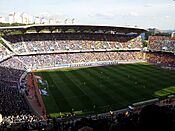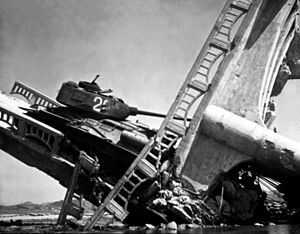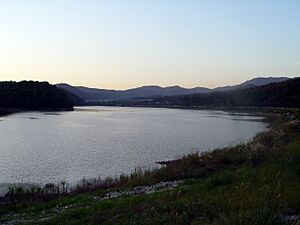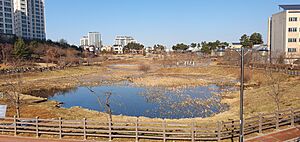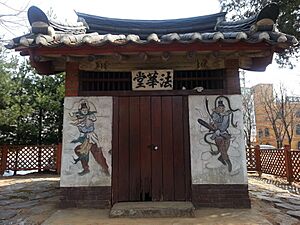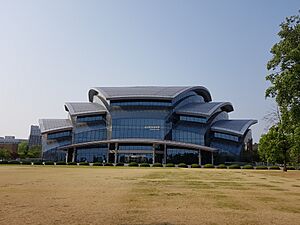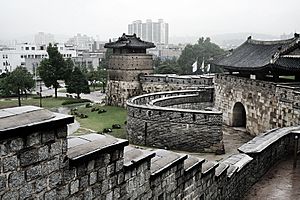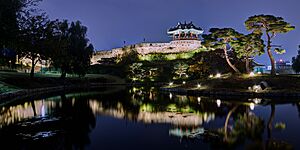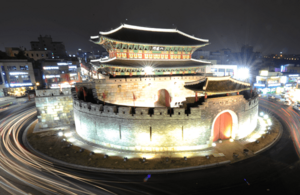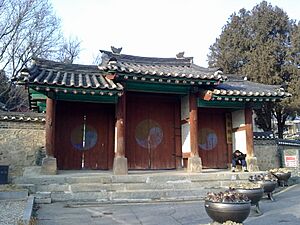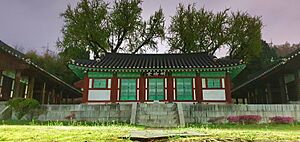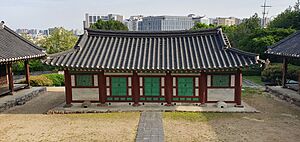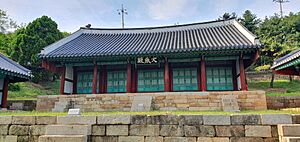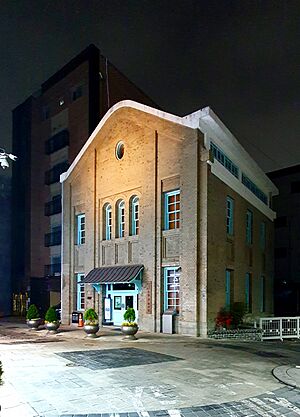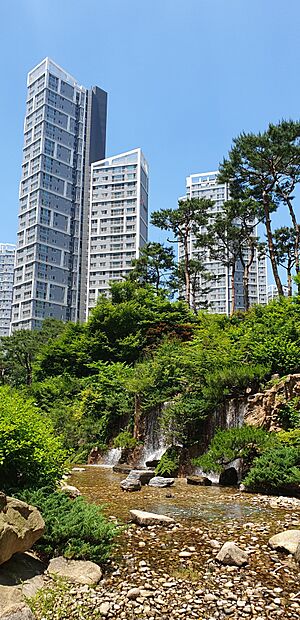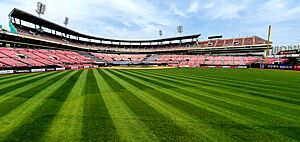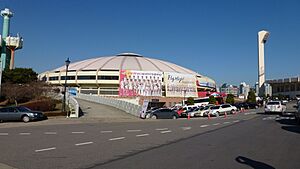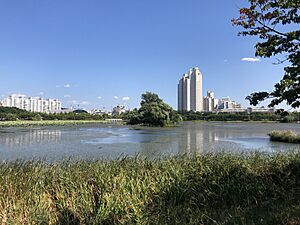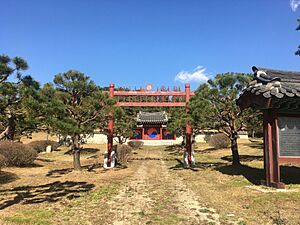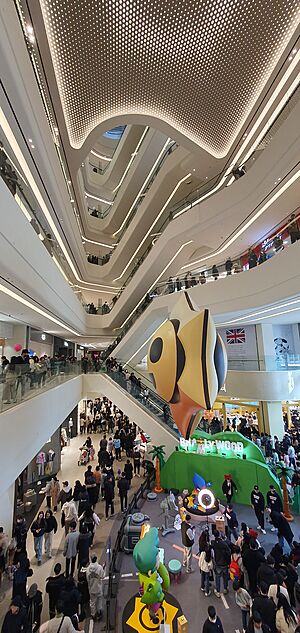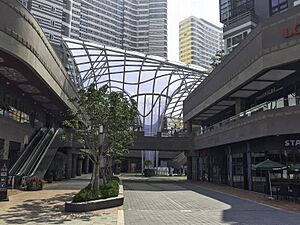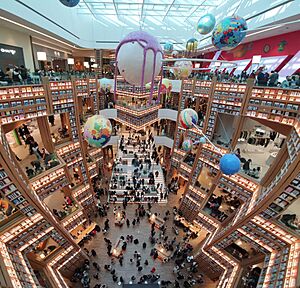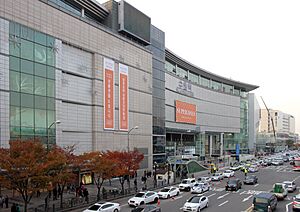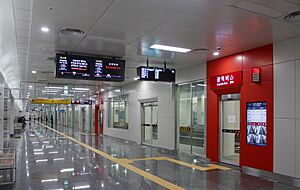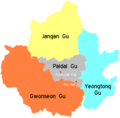Suwon facts for kids
Quick facts for kids
Suwon
수원
|
|||
|---|---|---|---|
| Korean transcription(s) | |||
| • Hangul | 수원시 | ||
| • Hanja | 水原市 | ||
| • Revised Romanization | Suwon-si | ||
| • McCune–Reischauer | Suwŏn-si | ||
|
From top, left to right:
view of Suwon from Paldalsan Mountain, Samsung Digital City (Samsung Electronics HQ), Suwon World Cup Stadium, Hwaseong Fortress, Gwanggyo Lake Park, Suwon Station |
|||
|
|||
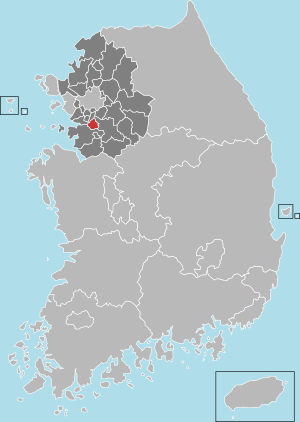
Location in South Korea
|
|||
| Country | |||
| Area | Gyeonggi Province (Seoul Capital) | ||
| Administrative divisions | 4 gu, 43 dong | ||
| Government | |||
| • Type | Mayor-Council | ||
| Area | |||
| • Total | 121.04 km2 (46.73 sq mi) | ||
| Highest elevation
(Gwanggyosan)
|
582 m (1,909 ft) | ||
| Population
(31 December 2023)
|
|||
| • Total | 1,233,424 | ||
| • Density | 10,190.2/km2 (26,392.5/sq mi) | ||
| • Dialect | Gyeonggi | ||
| Area code(s) | +82-31-2xx | ||
| Flower | Azalea | ||
| Tree | Pine | ||
| Bird | Egret | ||
| Website | Suwon City Council | ||
Suwon (Korean: 수원) is the biggest city and capital of Gyeonggi Province in South Korea. This province is the most populated in the country. Suwon is about 30 kilometers (19 miles) south of Seoul, the national capital.
With over 1.2 million people, Suwon has more residents than Ulsan Metropolitan City. It is known as a 'special case city', which means it has some extra powers compared to other cities, but not as much as a Metropolitan City.
Suwon is often called the 'City of Filial Piety' because of its history. It has many old landmarks, like the Hwaseong Fortress, a famous walled city. This fortress is a popular spot for tourists, with 1.5 million visitors in 2015.
The city is also very important for the economy. It is home to Samsung Electronics, a huge and very successful company in Korea. Samsung's main office and research center are in Suwon. Samsung is a big part of Suwon, even owning the professional football team, Suwon Samsung Bluewings. This team has won the K League four times! Suwon also has another football team, Suwon FC, and a baseball team called KT Wiz.
Suwon has several well-known universities, including Sungkyunkwan University and Ajou University. You can get around Suwon easily using expressways, trains, and the Seoul Metropolitan Subway.
Contents
- What Does Suwon Mean?
- Suwon's Past
- Suwon's Location and Nature
- How Suwon is Organized
- People of Suwon
- Learning in Suwon
- Environment and Nature
- Suwon's Industries
- Famous Places in Suwon
- Life in Suwon
- Getting Around Suwon
- Military Presence
- Animals of Suwon
- Famous People from Suwon
- Sister Cities
- Images for kids
- See also
What Does Suwon Mean?
The name Suwon means "water source." This meaning has been part of the area's name for a very long time. In ancient times, it was called Mosukuk. Later, it was known as Maehol, Maetkol, or Mulgol (매홀; 맷골; 물골; 買忽).
Over the centuries, the name changed several times. In 757 CE, it became Susŏng-gun (수성군; 水城郡; lit. Susŏng County). In 940, it was called Su-ju (수주; 水州; lit. Su Province). Finally, in 1310, it received its current name, Suwon.
Suwon's Past
Early Days
People have lived in the Suwon area since at least the early Bronze Age. Tools and pottery from that time have been found here. One important discovery site is Yeogisan, which is now a special monument in Gyeonggi Province.
During the Three Kingdoms of Korea period, Suwon was part of the Mosukuk statelet. It later became part of Goguryeo and then Unified Silla.
In the 10th century, Suwon joined Goryeo after a military campaign by King Taejo. It became an important administrative center for Gyeonggi Province in 1395, during the Joseon period.
In 1796, King Jeongjo moved Suwon's main center to its current spot. To protect the city, he ordered the building of Hwaseong Fortress, a strong wall around the town.
Japanese Colonial Period
During the time Korea was under Japanese rule (1910–1945), many Korean independence activists came from Suwon. People like Kim Se-hwan and Yi Sŏn-gyŏng were arrested for working to free Korea.
Korean War Times
Suwon became a city on August 15, 1949. When the Korean War started in 1950, Suwon was a key location. The first air battle of the war happened at Suwon Airfield on June 27, 1950. Suwon was captured by North Korean forces on July 4, 1950.
The city changed hands four times during the war. Suwon also hosted soldiers from other countries, like the Greek Expeditionary Force. A memorial for French forces was built in 1974 and updated in 2013.
Recent History
In 1964, the main offices of Gyeonggi Province started moving from Seoul to Suwon. This move was finished on June 23, 1967. This date is now celebrated as Suwon Citizen's Day.
Suwon has grown a lot over the years. Many villages were added to the city in 1963, 1983, 1987, 1994, and 1995. New districts like Gwonseon-gu and Paldal-gu were created in 1988, and Yeongtong-gu in 2003.
Suwon's Location and Nature
Geography
Suwon is located in the northern part of the Gyeonggi plain. It is bordered by Uiwang to the northwest, Yongin to the east, Hwaseong to the southwest, and Ansan to the west. Suwon is also quite close to the Yellow Sea.
Mountains and Streams
The northern part of Suwon is hilly, with Gwanggyosan being the highest point at 582 meters (1,909 feet). Most of Suwon's streams, like the Hwanggujicheon and Suwoncheon, start in these northern hills and flow south towards the Yellow Sea.
Suwon has several lakes, but they are actually small reservoirs built by people. Some of these include Seoho (서호) near Hwaseo Station, Irwol Reservoir (일원 저수지), and Gwanggyo Reservoir (광교 저수지). Irwang Reservoir, also called Manseokkeo, is even a world heritage site for its role in irrigation.
Climate
Suwon has a climate with warm, humid summers and cold winters. The city can sometimes experience flooding, like in 1998 and 2010 when heavy rains fell.
How Suwon is Organized
Administrative Divisions
Suwon is divided into four main areas called gu (districts). These are Jangan-gu, Gwonseon-gu, Paldal-gu, and Yeongtong-gu. Each of these districts is then split into smaller neighborhoods called dong.
Newer areas like Homaesil and Gwanggyo have also been developed. Gwanggyo is especially known for having some of the most expensive housing in Gyeonggi Province.
People of Suwon
Population and Diversity
As of December 31, 2023, Suwon had 1,233,424 people. Slightly more than half of the population is male (50.3%), and about 2.9% of residents are from other countries. On average, there are 2.3 people living in each household.
| Total people | Korean males | Korean females | Korean (total) | Foreign males | Foreign females | Foreign (total) | |
|---|---|---|---|---|---|---|---|
| Suwon (total) | 1,233,424 | 602,346 | 594,911 | 1,197,257 | 17,837 | 18,330 | 36,167 |
| Gwonseon-gu | 375,574 | 184,970 | 181,197 | 366,167 | 4,558 | 4,849 | 9,407 |
| Jangan-gu | 277,645 | 136,145 | 134,704 | 270,849 | 3,312 | 3,484 | 6,796 |
| Paldal-gu | 208,791 | 99,290 | 97,923 | 197,213 | 5,917 | 5,661 | 11,578 |
| Yeongtong-gu | 371,414 | 181,941 | 181,017 | 363,028 | 4,050 | 4,336 | 8,386 |
Religion
The Catholic Diocese of Suwon was created in 1963. Its main church, St. Joseph's Cathedral, is in Jeongja-dong.
Mireukdang (미륵당), a small shrine dedicated to Maitreya, is in Pajang-dong. It combines elements of Buddhism and local traditional beliefs.
Learning in Suwon
Universities and Colleges
Suwon is home to several universities and colleges. These include Sungkyunkwan University's Natural Sciences Campus, Kyonggi University, and Ajou University.
It's interesting to note that the University of Suwon and Suwon Science College are not actually in Suwon, but in the nearby city of Hwaseong.
Schools for All Ages
Suwon has many schools for younger students:
- 44 high schools
- 57 middle schools
- 100 primary schools
- 180 kindergartens
There are also three schools specifically for special education: Jahye School, Suwon Seokwang School, and Areum School. Suwon also has two international schools: Gyeonggi Suwon International School and Suwon Chinese International School.
Environment and Nature
Water Management
Managing water is important in South Korea, and Suwon is working to be more self-sufficient with its water supply. The city plans to get 50% of its water from rainwater harvesting and by cleaning and reusing sewage.
Air Quality
Air pollution in Suwon comes from various sources, including industries and vehicles. For example, a lot of the coarse dust (PM10) in the air comes from soil, industrial activities, and vehicle emissions.
PM10 sources on the Suwon–Yongin border: Soil (25.4%) Secondary sulphate (produced in the atmosphere by photochemical processes acting on sulphuric compounds) (22.1%) Industry and oil combustion (13.8%) Secondary nitrate (produced by oxidation of some volatile organic compounds) (12.3%) Diesel emissions (12.1%) Gasoline emissions (5.6%) Sodium-rich sources (5.6%) Waste incineration (3.1%)
Suwon's Industries
The biggest employer in Suwon is Samsung Electronics. This company started in Suwon in 1969 and still has its main office and a large research center here. Samsung's presence is very noticeable in the city, as they sponsor local sports teams like the Suwon Samsung Bluewings Football Club. Other major companies in Suwon include SK Chemical, Samsung SDI, and Samsung Electro-Mechanics.
Famous Places in Suwon
Hwaseong Fortress
Hwaseong Fortress, built in 1796 by King Jeongjo, is a UNESCO World Heritage Site. The fortress walls used to surround the entire city. Today, Suwon has grown much larger than the fortress. There are four main gates, and Haenggung Palace is in the center.
The fortress was built with the help of philosopher Jeong Yak-yong. Workers were paid for their labor, which was new for Korea at the time. All the building details were carefully written down in a book called Hwaseong Seongyeok Uigwe (화성 성역 의궤). This book was very helpful for rebuilding the fortress after the Korean War.
Hyanggyo
Suwon Hyanggyo (수원향교; 水原鄕校) was a government school and a place for Confucian ceremonies during the Goryeo and Joseon periods. It was the largest and oldest state school in Gyeonggi Province during the Joseon Dynasty.
The school was moved to its current spot in Gyo-dong around 1795, when Hwaseong Fortress was built. It has special tablets honoring Confucius and other important Korean Confucian figures. You can visit the school on weekdays.
Bugugwon
Bugugwon (부국원), also known as Suwon Gu Bugugwon, is an old building that was built before 1923. It's now a cultural center in Gyo-dong. In the past, it was used for different purposes, like a company office, a court, and even a political party's base. Since 2018, it has been a public cultural space.
Adams Memorial Hall
Adams Memorial Hall was an important meeting place for the independence movement. Built in 1923, it was funded by a church in the United States, a local church, and residents. Independence activists used to meet here weekly to plan their activities.
Life in Suwon
Housing
Like many cities in South Korea, Suwon has many apartment buildings. The cost of housing can change a lot, and homes in Yeongtong-gu are some of the most expensive in the province.
Food
Suwon is famous for its Suwon galbi, which is a special type of beef ribs enjoyed all over Korea.
Sports
Suwon is a big sports city! The Suwon World Cup Stadium was built for the 2002 FIFA World Cup. It's now the home stadium for the K League 2 football team Suwon Samsung Bluewings.
Suwon also has other football teams, Suwon FC (men's) and Suwon FC Women (women's), who play at Suwon Sports Complex.
Since 2013, Suwon has been home to the professional baseball team KT Wiz. They play at the Suwon Baseball Stadium.
Basketball also has a history in Suwon. The Seoul Samsung Thunders (men's) and Samsung Life Blueminx (women's) teams used to be based here. In 2021, the KT Sonicboom men's basketball team moved to Suwon.
The Suwon Gymnasium is home to two professional volleyball teams: Suwon KEPCO Vixtorm (men's) and Suwon Hyundai Engineering & Construction Hillstate (women's). This gymnasium has also hosted international sports events, including handball in the 1988 Summer Olympics and the 2014 Asian Games.
Museums
Suwon has two national museums. The National Map Museum of Korea has a collection of over 33,000 maps. It's free to enter and open daily. The National Agricultural Museum of Korea, which opened in 2022, is also free and open daily.
There are also smaller museums, like the Suwon Hwaseong Museum, which explains how Hwaseong Fortress was built. Another unique museum is Haewoojae, which is all about the history of toilets! It has even gained international attention.
Libraries
Suwon Central Library opened in 1980. Today, the city has 27 public libraries spread across its districts. The city council plans to build even more libraries in the future.
Parks and Gardens
Suwon has two special gardens called arboreta: Irwol Arboretum (일월 수목원) and Yeongheung Arboretum (영흥 수목원). They both opened in May 2023 and have thousands of different plant species.
The city also has 338 parks. Some of the larger ones, like Gwanggyo Lake Park, Seoho Park, and Manseok Park, include big lakes.
Street Art
The areas of Haenggung-dong and Ji-dong in central Suwon are famous for their colorful murals and other artistic features, including cool optical illusions on the streets.
Media
Suwon has several local newspapers, including the Kyeonggi Ilbo and the Kyeongin Ilbo. The national TV broadcaster KBS also has a drama studio and art hall in Suwon that you can visit by appointment.
Cinemas
You can find many movie theaters in Suwon. There are several branches of major cinema chains like CGV, Lotte Cinema, and Megabox. There are also smaller cinemas that might show more local films.
Shopping
Suwon has many large shopping centers. Some popular ones include AK Plaza and Lotte Mall near Suwon Station, and Avenue France in Gwanggyo. A new large shopping mall called Starfield opened near Hwaseo Station in January 2024. Starfield Suwon is designed to attract younger people and often hosts special pop-up stores. It also has a unique library and a Megabox cinema inside.
Public Toilets
In the early 2000s, Suwon City Council worked hard to improve its public restrooms. They even offered guided tours of the facilities! Suwon has hosted international meetings about toilet management, and the World Toilet Association is based in the city.
Getting Around Suwon
Suwon Station is a major train station where you can catch KTX trains that connect Seoul to Busan. Suwon is also served by three lines of the Seoul Metro, with 14 stations in the city. There are plans to expand the subway network even further.
Suwon has two inter-city bus terminals that connect to cities across the country. You can also find many city and express buses to Seoul and other nearby areas. Suwon has invested in electric buses and has the country's largest bus charging station.
Several expressways pass through Suwon, making it easy to travel by car. The Yeongdong Expressway and Pyeongtaek–Paju Expressway both have exits in Suwon.
Eco-Friendly Travel
Suwon is committed to eco-friendly transportation. It was the first city in Korea to offer public bicycles that you can pick up and drop off anywhere. The city also has many bike paths along its streams. In 2013, Suwon hosted the EcoMobility World Festival, where streets in Haenggung-dong were closed to cars for a month, and residents used non-motorized vehicles.
Military Presence
Suwon Air Base was used by the United States Air Force during the Korean War and was the site of the war's first air battle. Today, the base is managed by the Republic of Korea Air Force, but the US military still helps maintain it.
Animals of Suwon
While many animals in Suwon are similar to those found in the surrounding province, two species are especially interesting. The white-breasted waterhen was recorded breeding in Suwon for the first time in Korea. Also, the Suwon tree frog, discovered around 1980, is no longer found in the city due to urban growth. However, it has been seen in other parts of Gyeonggi Province and is considered an endangered species.
Famous People from Suwon
Suwon has been the birthplace or home of many notable people throughout history.
- Historical Figures:
- Choi Ru-baek (d. 1205), famous for his loyalty to his parents.
- Na Hye-sok (1896–1948), an influential feminist, painter, writer, and journalist.
- Woo Ha-yŏng (1741–1812), a scholar and pioneer in agriculture.
- Independence Activists (Japanese Colonial Period):
- Lim Myŏn-su (1874–1930)
- Cha In-chae (1895–1971)
- Kim Se-hwan (1889–1945)
- Lee Sŏn-gyŏng (1902–1921)
- Artists:
- Yoon Han-hŭm (1923–2016)
- Kim Sung-bae (1954–)
- Sports Players:
- Chung Hyeon (1996–), a tennis player.
- Dong Hyun Kim (1981–), an MMA fighter.
- Park Ji-sung (1981–), a famous football player. A street in Suwon was named after him in 2005.
- Classical Musicians:
- Han-na Chang (1982–), a conductor and cellist.
- Seol Yoeun (2012–), a young violinist.
- Popular Musicians (K-Pop Idols, etc.):
- Im Chang-kyun (1996–)
- Jeon Ji-yoon (1990–)
- Jo Kwon (1989–)
- Lee Jin-ki (1989–)
- Shin Dong-hee (1985–)
- Yoo Jeongyeon (1996–)
- Yoo Ji-min (2000–)
- Yoon Bo-mi (1993–)
- Actors:
- Joo Won (1987–)
- Lee Jong-suk (1989–)
- Park Hae-soo (1981–)
- Ryu Jun-yeol (1986–)
- Song Kang (1994–)
- Other Notable People:
- Pastor Kim Jang Hwan (1934–), a former president of the Baptist World Alliance.
- Sam Oh (1980–), a presenter and columnist.
Sister Cities
Suwon has special partnerships with many cities around the world. These are called "sister cities" and help promote friendship and understanding.
 Asahikawa, Japan (1989)
Asahikawa, Japan (1989) Jinan, China (1993)
Jinan, China (1993) Townsville, Australia (1997)
Townsville, Australia (1997) Bandung, Indonesia (1997)
Bandung, Indonesia (1997) Yalova, Turkey (1999)
Yalova, Turkey (1999) Cluj-Napoca, Romania (1999)
Cluj-Napoca, Romania (1999) Toluca, Mexico (1999)
Toluca, Mexico (1999) Fez, Morocco (2003)
Fez, Morocco (2003) Hải Dương Province, Vietnam (2004)
Hải Dương Province, Vietnam (2004) Siem Reap Province, Cambodia (2004)
Siem Reap Province, Cambodia (2004) Nizhny Novgorod, Russia (2005)
Nizhny Novgorod, Russia (2005) Curitiba, Brazil (2006)
Curitiba, Brazil (2006) Freiburg im Breisgau, Germany (2015)
Freiburg im Breisgau, Germany (2015) Phoenix, United States (2021)
Phoenix, United States (2021) Toury, France (2023)
Toury, France (2023) Mississauga, Canada (2023)
Mississauga, Canada (2023)
Suwon also has sister city relationships with other cities in Korea:
Images for kids
See also
 In Spanish: Suwon para niños
In Spanish: Suwon para niños




